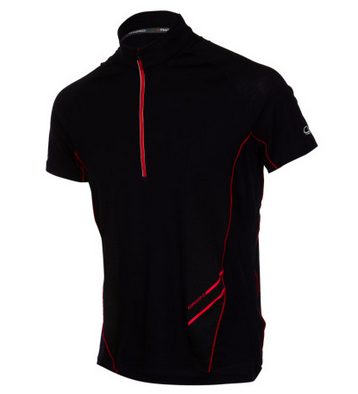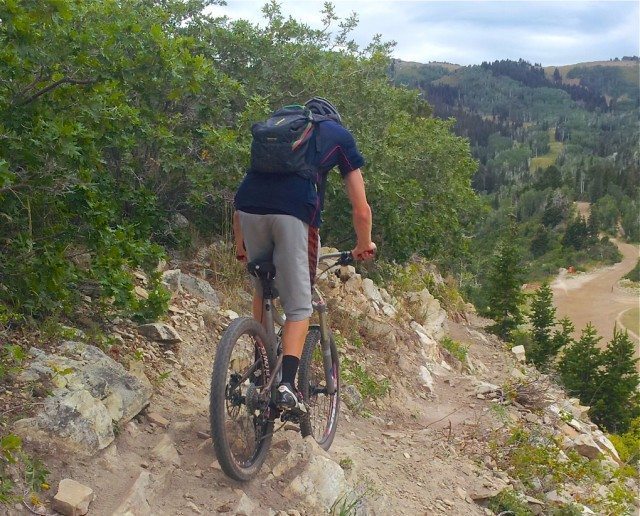
Icebreaker Sonic Short Sleeve Half Zip
Intended Use: Base layer—Cycling / Running / Other Aerobic Sports
Material: 96% merino wool, 4% elastane. Eyelet panels: 99% merino, 1% elastane
Color: Admiral
Size Tested: Large
Fit: Regular
MSRP: $89.99
Reviewer Size: 6’0”, 160 lbs., Chest: 40”, Shirt Sleeve Length: 38”
Days Tested: 20+
Test Locations: Salt Lake and Park City area, Utah; Whitefish, Montana
Last winter, the Icebreaker Sprint Crewe quickly became my base layer of choice. The functional aspects of merino wool are hard to beat—the fabric is soft and comfortable, it regulates temperature exceptionally well, pulls moisture away from the skin, and dries quickly. Perhaps most impressively, it executes all of these tasks while remaining stench free, something most synthetics can’t do.
As mountain bike season rolled around, I found myself again disappointed in the synthetic materials commonly used in jerseys, and the question, “Why the hell do I not have a merino mountain bike jersey?” floated around in my head. After shopping around a bit I figured out why—they are really hard to find, especially if you want to stay away from the form fitting, road cyclist / XC race look.
While the Icebreaker Sonic Short Sleeve Half Zip is a bit snugger than I would prefer, I still wanted to try it out, because I wanted to see if a merino shirt could hold up to a season of riding, or if it would to be too hot for summer in Utah.

Construction
Like all Icebreaker products, the Sonic Short Sleeve Half Zip is primarily composed of natural, sustainable, traceable, New Zealand merino wool. The shirt comes from the company’s Base Layer Ultralite collection, and uses 150 g/m2 wool. Since it’s part of the Icebreaker GT series, it features a touch of Lycra. Icebreaker claims the addition of elastane makes for a “great fit,” and the use of finer yarns facilitates faster drying times.
A distinctive feature of this particular Icebreaker shirt is the use of eyelet mesh panels, a fabric with larger diameter holes, which makes up the majority of the back and side area. This fabric is intended to provide “maximum venting and mobility,” which I’ll talk about later.

The majority of seams use what Icebreaker calls a “flatlock” stitch, which as the name implies, lies flat and is very comfortable. There are a few seams with a bulkier stitch, something you notice when you put the jersey on.
The half-length zipper has worked without a single hitch throughout the season. If I had one gripe concerning the zipper, it would be the bulk of material used to keep the zipper away from the skin. The idea is great, but the thickness of the material on this shirt seems a little excessive. Instead of a cool zipper bumping against my skin, I have a relatively large section of fabric on my chest.
Additionally, the jersey features a hidden pocket along the right waistline. The pocket runs vertically, measures about 6cm x 17cm, and has a portal to run headphone wires inside the shirt. It seems about perfect for a small music player or a stash of cash.
Fit / Sizing
My body and Icebreaker’s ideal body appear to be different. I typically wear a size large MTB jersey, so that is what I went with in the Sonic. Much like the Sprint L/S Crewe I wore over the past winter, the body of the Sonic fits very well (although it is form fitting, even on my thin self).
The sleeves, however, are on the short side, especially when I’m hunched over the bike. I do have longer-than-average arms, so keep that in mind. Luckily, the material is very stretchy, so while I never found the sleeves uncomfortable, they did make me a bit self-conscious.
The body length is adequate for the hunched over MTB position. The Sonic measures 27″ from the collar to the bottom of the shirt. It’s long enough so that it doesn’t ride up over my waistline when I’m using a hydration pack, causing others to wonder what a plumber is doing on their favorite singletrack.

Breathability
In my experience, merino is the best fabric when it comes to combining comfort, quick drying ability, and odor resistance. But one big question I had coming into this review was if even the ultralight 150 g/m2 wool would be too hot for a summer in Utah.
I know all the marketing campaigns claim merino can “keep you warm and keep you cool,” but I wanted to actually feel what it was like to wear a wool shirt in temperatures above 90 degrees while creeping up a 2500’+ climb.
Well, like with any other jersey, on those days I was super hot myself. The Sonic, however, did feel noticeably warmer than my Dakine and O’Neill synthetic jerseys.
Interestingly, the Sonic felt warmest in the “maximum ventilation” areas that used the eyelet mesh panels. Because of this, I strongly believe the shirt would have performed better in hot conditions if it was made strictly from the 96% merino, 4% elastane fabric, like the Sprite Racerback Tank Stella Selden tested over the summer. The finer thread of this material actually seems to be lighter and cooler, and it dries faster.
Since the Sonic jersey was a bit warmer than other shirts I’ve tried, the half length zipper was a welcome feature, and I routinely had it open on hot climbs.
As summer gives way to fall and more moderate temperatures (say, ~75F and below), the Sonic has been functionally perfect. It’s become my go-to jersey.
NEXT PAGE: Durability

I’ll be right there with you Jason when somebody starts making a nice merino jersey. I use Icebreaker 150 weight t-shirts in both 100% merino and 96/4 % as above. I notice the elastane versions are noticeably thinner and thus absorb less water, dry quicker, and are cooler. The 100% t’s just get too heavy when wet. Unfortunately merino will never be ‘durable’ as it easily snags on anything, especially the velcro that exists on EVERY pair of riding shorts, but I’m still willing to pay the premium for the wool comfort.
In the meantime I might treat myself or ask the girlfriend for Christmas to one of the uber pricey Kitsbow jersey to see how their blend of merino/poly holds up. As I HATE to wear a pack, I see myself next season rocking the new undershort bibs w/ pockets (which I urge BlisterGear to review) that both Giro
Hi, I have some merino clothes Icebreaker, Patagonia , Arcteryx,,, All of these are excellent, the new merino fibers are one of the best advantages in clothes technology in time, if you are looking for a btt merino clothes, you can see Ibex, they’re good too.